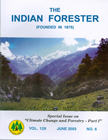Possible Impact of Climate Change on Tree Species Composition and Diversity in Lowland Evergreen Forests of Kerala , Western Ghats
DOI:
https://doi.org/10.36808/if/2003/v129i6/2342Abstract
The major climatic change predicted in the lowland areas in India is the rise in the water table. Thus a comparative study for the phytosociological features was carried out to predict the possible impact of climate change by selecting a swamp forest (altitude 76m above msl) and a forest patch located at an altitude 372m above msl. In both the plots , species of Myristicaceae are dominant. However , the contribution by these species to the total Importance Value Index (lVI) is relatively less in the higher altitude forest plot. In addition , these species show certain morphological features such as stilt roots only when they are growing in the swampy area. Thus it is predicted that due to increase in water table , a consequence of climate change , the vegetation structure and composition in relatively higher altitude plots oflowland forests may simulate those of Myristica swamp forest. The study also indicated that the human disturbance alters the vegetation structure and composition , which is different from that by climate change. Thus it is suggested that monitoring and detection of vegetation responses to climate changes should be done by carefully selecting the plots which do not show any sign of other kinds of disturbance.Downloads
Download data is not yet available.
Downloads
Published
2003-06-01
How to Cite
Chandrashekara, U. M., & Sreejith, K. A. (2003). Possible Impact of Climate Change on Tree Species Composition and Diversity in Lowland Evergreen Forests of Kerala , Western Ghats. Indian Forester, 129(6), 770–775. https://doi.org/10.36808/if/2003/v129i6/2342
Issue
Section
Articles
License
Unless otherwise stated, copyright or similar rights in all materials presented on the site, including graphical images, are owned by Indian Forester.





